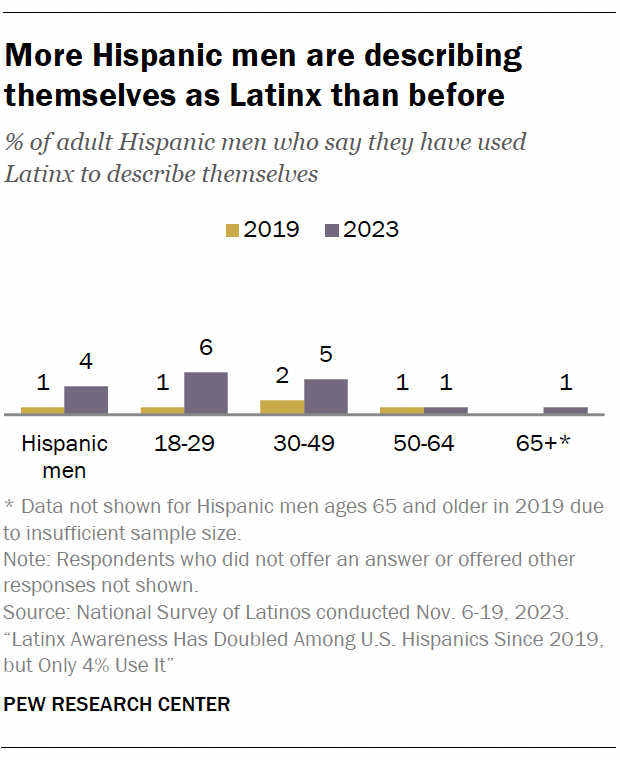
Alternatives to the pan-ethnic labels Hispanic and Latino emerge every so often.5 But none have been widely adopted or embraced by the population they are meant to describe. And few Hispanic adults have even heard of some of them.
“Latinx” is a recent pan-ethnic label that emerged to describe the U.S. population that traces its roots to Latin America and Spain. Awareness of it among U.S. Hispanics has grown, but use remains low. This chapter explores patterns of Latinx awareness and use among the U.S Hispanic population.
Awareness of Latinx among U.S. Hispanics grows
Nearly half (47%) of Latino adults in 2023 say they have heard of the pan-ethnic term Latinx, about double the share who were aware of it in 2019. And this rise in awareness is widespread across many demographic subgroups of U.S. Latinos. Yet there are large differences among some of these subgroups.

By age
- 60% of Latinos ages 18 to 29 have heard of Latinx. Awareness of the term drops to 47% among those ages 30 to 49 and falls to 34% among those 65 and older.
By nativity
- 62% of U.S.-born Latinos have heard of Latinx. They are about twice as likely as Latino immigrants (31%) to be aware of the term.
By language
- 62% of Hispanic adults who are predominantly English speakers and 55% who are bilingual in English and Spanish are aware of Latinx.
- By contrast, just 17% who are predominantly Spanish speakers say the same.
By education
- 74% of Latinos with a bachelor’s degree or more education are aware of Latinx.
- By comparison, 31% who are high school graduates or less have heard of it.
By political party
- 52% of Latino Democrats and Democratic leaners and 48% of Latino Republicans and Republican leaners have heard of Latinx. In 2019, Republicans were about half as likely as Democrats to be aware of the term.
By sexual orientation
- 67% of lesbian, gay or bisexual Latinos have heard of Latinx, while nearly half of straight Latinos say the same.
Who uses Latinx?

Few adults of Hispanic or Latino origin have used Latinx to describe themselves, despite the growth in familiarity with the term. Just 4% say they use Latinx to describe themselves, similar to the share (3%) who reported using it in 2019.
While few Hispanics overall say they use Latinx, usage is higher among some demographic subgroups.
By age
- 7% of Hispanics ages 18 to 29 say they have used Latinx to describe themselves.
- By comparison, just 2% of Hispanics ages 50 or older say they use Latinx.
By Afro-Latino identity
- 9% of Hispanics who identify as Afro-Latino say they use Latinx to describe themselves.
- 4% of those who don’t identify as Afro-Latino say the same.
By sexual orientation
- 13% of Hispanics who identify as lesbian, gay or bisexual say they use Latinx to describe themselves, while 3% who identify as straight say the same.
Use among Hispanic men and women

In addition, there has been a small uptick in Latinx use among Hispanic men in recent years.
- 4% of Hispanic men say they have used Latinx to describe themselves, compared with 1% who said the same in 2019.
This increase in use is in part driven by young men. Among Hispanic men ages 18 to 29, 6% say they use Latinx, compared with 1% who said the same in 2019.
Among Hispanic women, the share who use Latinx is similar to 2019 (4% in 2023 and 5% in 2019).
